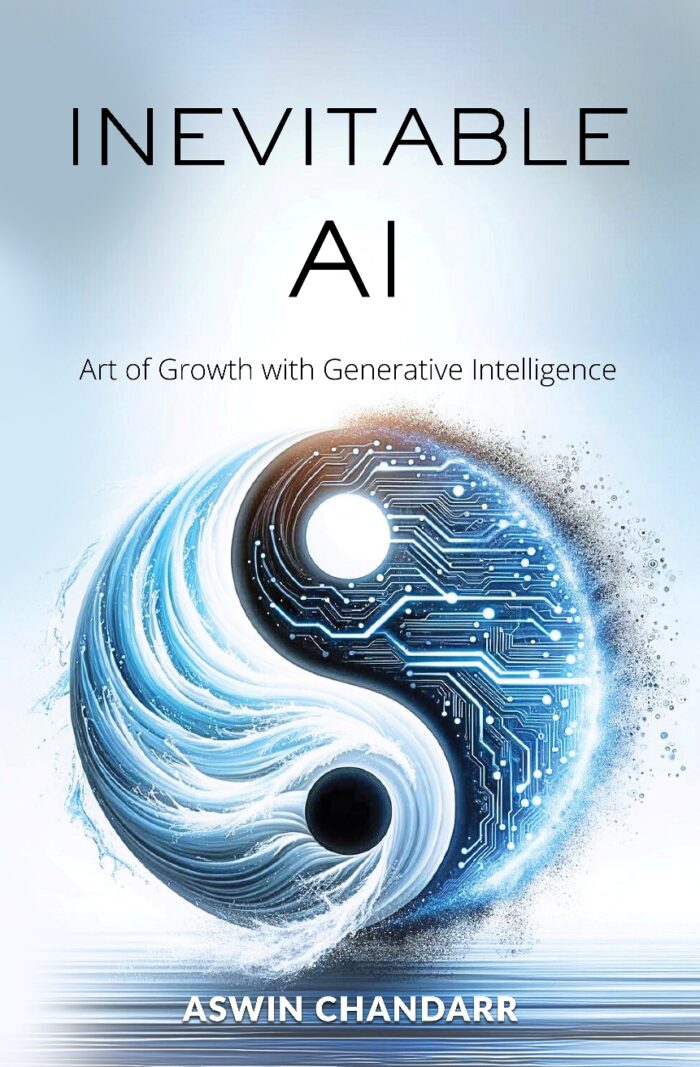
While there is an overwhelming amount of conversations on AI globally only a select few across the world know what it actually is, what it can or cannot do and why? We are delighted to announce a book that captures this knowledge and provides the same to you in nuggets called ‘Inevitable AI: Art of Growth with Generative Intelligence’ by Aswin Chandarr.
The book offers a comprehensive exploration of the transformative potential of artificial intelligence (AI) in the realm of growth and innovation. Starting from knowing what is Artificial Intelligence, to understanding its working model by using cartoons, illustrations, stories and captivating dialogues. From getting the idea of how it can change your ideas into vision to understanding how Artificial Intelligence makes your life easier, can help you make your daily work easy. The book also talks about complex topics such as machine learning, creativity over AI, and the ethical implications of AI, all while maintaining a clear and engaging narrative style. The author excels in breaking down intricate concepts into digestible explanations, making the book suitable for both novices and those with a technical background.
It gives a perfect recipe for working professionals on transforming themselves to be relevant in the age of AI. It gives Investors a sound framework for placing their bets and funding new ventures. It gives Entrepreneurs and Enterprises a structured way to create and use new AI products.
GAN -The Convergence of Creativity and Critique
Imagine a crime mystery novel featuring two main characters: a masterful counterfeiter and an astute detective. The counterfeiter’s job is to create perfect counterfeit money that looks identical to real currency, and the detective’s mission is to distinguish real money from fake money.
The counterfeiter starts his operations and passes the forged money around town. Using his keen eye and expertise, the detective looks at each piece of currency, determining if it is real or counterfeit. Whenever the detective finds a counterfeit bill, he studies it, identifying the telltale signs that gave it away. He then provides this feedback to the counterfeiter, not intending to arrest him but to push him to improve his forgery skills.
Encouraged by the challenge, the counterfeiter uses this feedback to refine his techniques, making his counterfeit currency increasingly indistinguishable from the real thing. This back-and-forth dance continues, with the counterfeiter getting better at producing convincing fakes and the detective getting sharper at detecting them.
When considering the vast landscape of artificial intelligence, the coexistence and convergence of discriminative and generative AI models represent one of the most exciting frontiers. One such exemplar of this harmony is Generative Adversarial Networks (GANs). As the name suggests, GANs pit generative and discriminative models against each other, resulting in a powerful system that can create, refine, analyze, and invent.
Now, replace the counterfeiter with a generative model and the detective with a discriminative model, and you have the essence of a GAN or a Generative Adversarial Network. The generative model creates (forgeries), and the discriminative model discerns (detects). Their dynamic rivalry propels them to improve, creating highly realistic outputs, whether they are images, text, or something else.
The power of GANs lies in the competition and cooperation between these two elements. As the generative model gets better at producing convincing content, the discriminative model must improve its ability to discern the real from the fake. This ongoing adversarial relationship leads to both models’ continuous refinement and improvement.
So, what does this mean for practical applications? The promise of GANs is nearly as broad and varied as the field of AI itself. They have been used to generate realistic human faces, translate images from winter to summer, create 3D models from 2D images, and much more. In art and entertainment, GANs can be used to create original art pieces, design clothing, and generate unique character models for video games. In healthcare, GANs have the potential to generate synthetic medical data, which is useful for research in areas where data collection can be challenging due to privacy concerns. They could also create detailed 3D models of organs to assist doctors in surgery planning. As GANs evolve and improve, their potential applications will only broaden. By unifying the forces of generative and discriminative models, GANs unlock a new dimension of machine intelligence.
Before we dive into why AI has taken center stage in our everyday conversations and why it seems we cannot go a single day without hearing mention of it, let’s take a slight detour. It’s important to untangle the web of technical terms that have entered our regular vocabulary through metaphors and make them more digestible for everyone. You can skip to the last lines of this chapter if the technical jargon does not evoke your curiosity.

About The Author
Aswin Chandarr is a distinguished figure at the forefront of artificial intelligence (AI) and robotics, embodying the roles of an entrepreneur, author, and educator. With over 18 years of ground breaking work in AI and robotics, Chandarr has dedicated his career to unravelling the complexities of technology and its implications for humanity’s future.
As the visionary founder of The Global AI Transformation Institute, Chandarr has created a pivotal platform committed to demystifying AI’s vast capabilities and potential for societal benefit. Promoting a multidimensional view of technology as a force for global progress and innovation, it offers unparalleled consulting and training that intersects business, education, and policy. With a rich academic background, including a Ph.D. and an MBA from prestigious institutions in the Netherlands and the USA,
Aswin can demystify complex technical terms with astonishing simplicity. His work extends beyond academia into the tangible world, where he has pioneered multiple robotics companies, such as Robot Care Systems and Loop Robots. These ventures focus on integrating robots into daily life to address some of society’s most pressing challenges, particularly in elderly care and healthcare. Chandarr’s work as a futurist is not just about predicting the future; it’s about creating it. His insights into the evolving landscape of AI and robotics are profound and actionable, encouraging others to engage proactively with the future of technology.
Excerpt – Pg 42-44
( Extracted with due permission from author, publisher)
[the_ad id=”55723″]


















